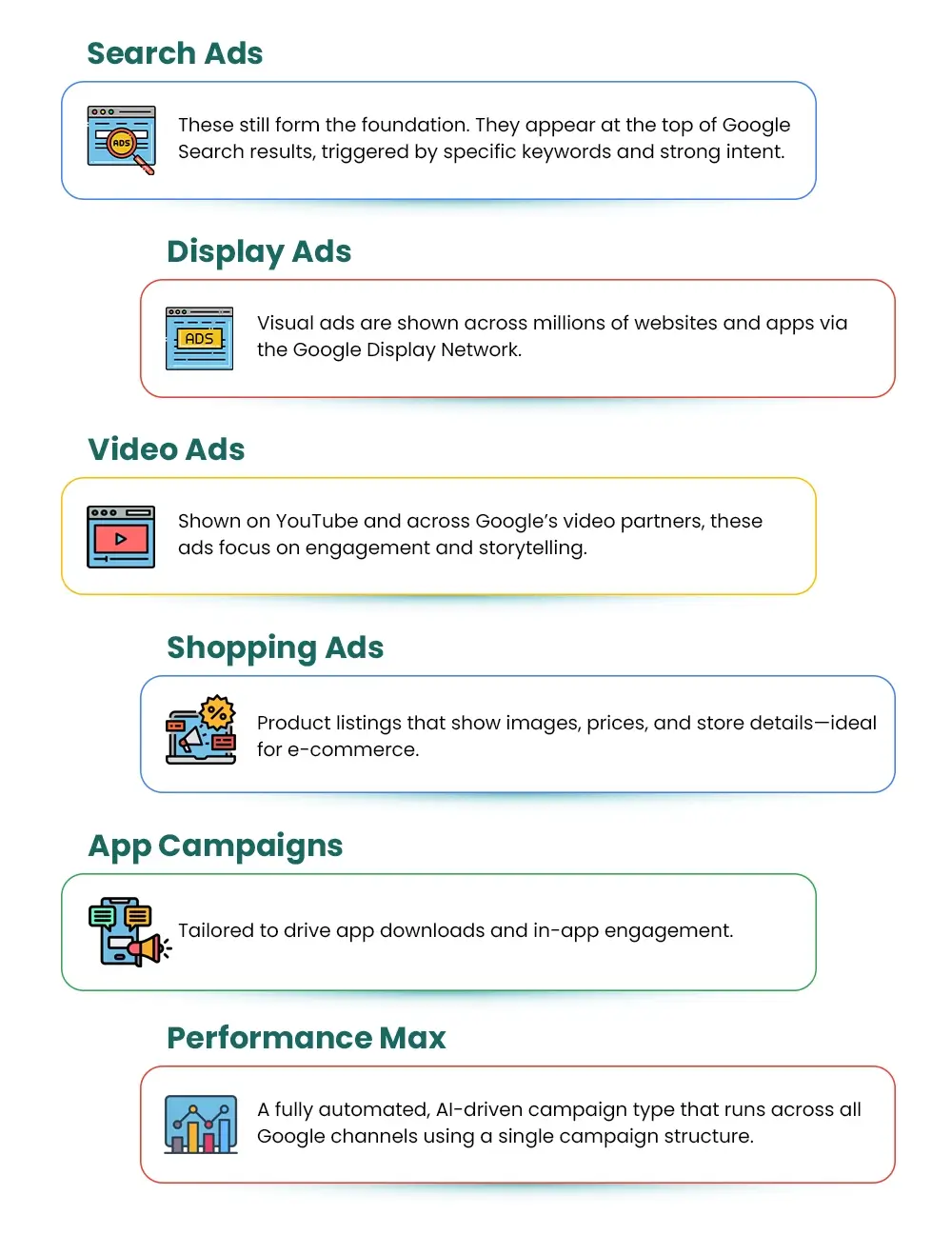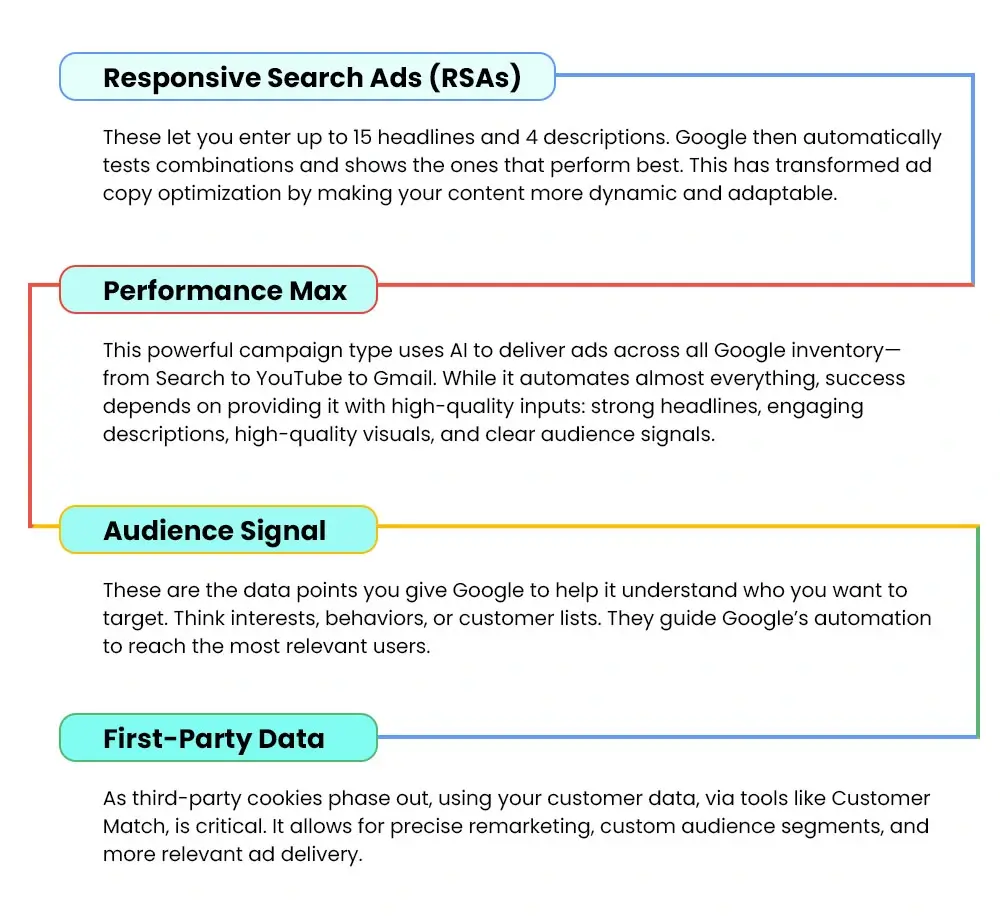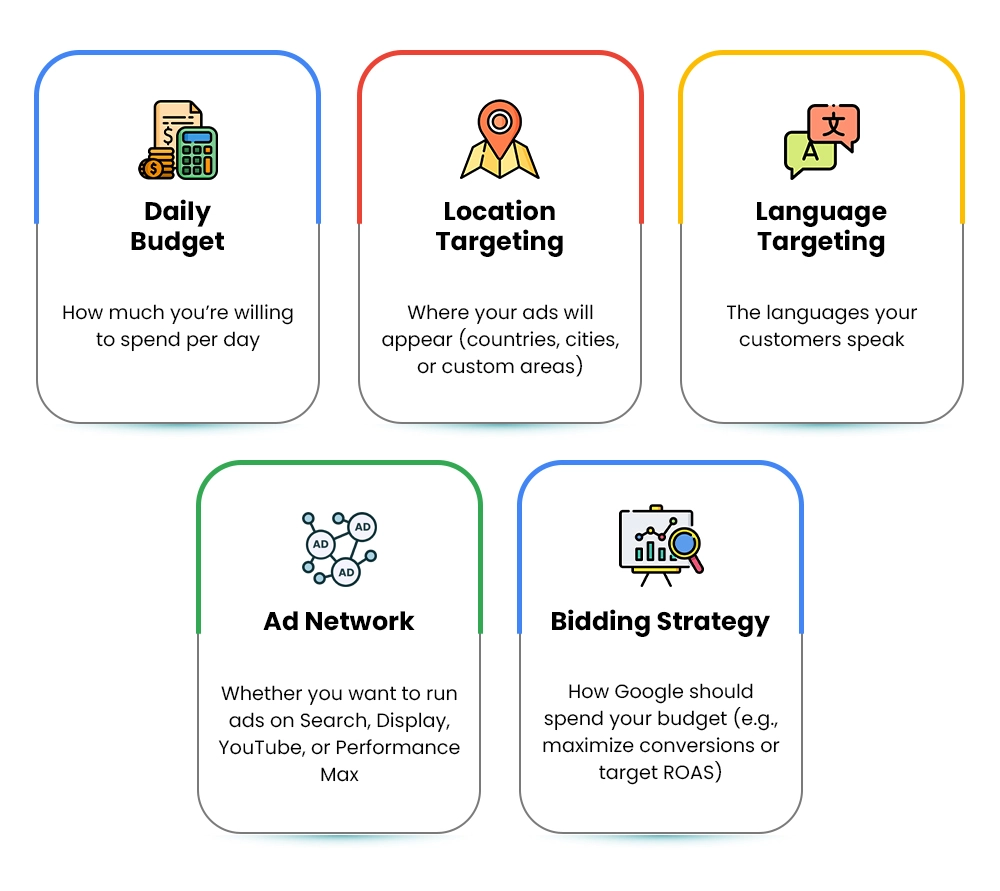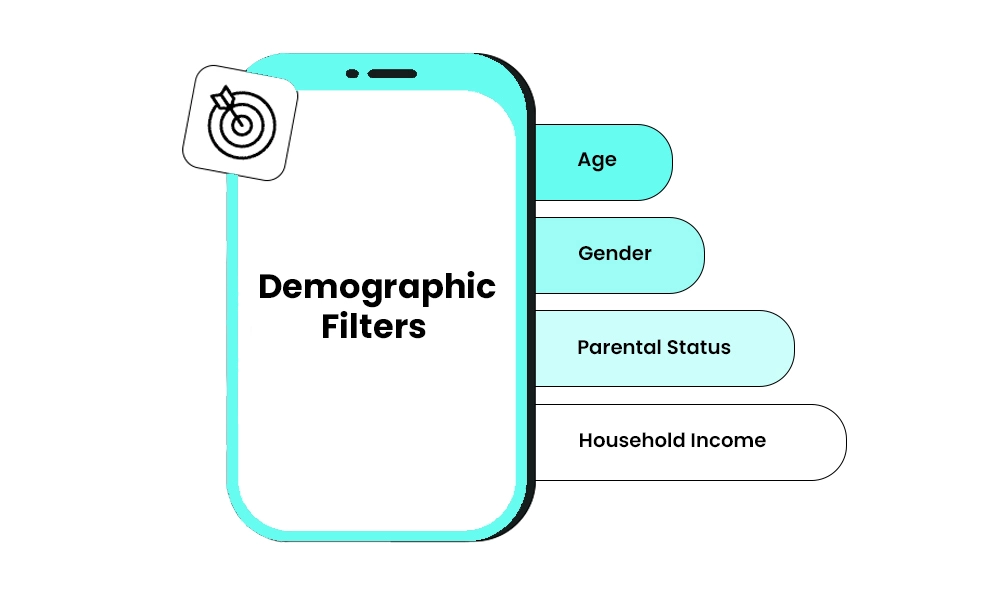Google Ads Best Practices in 2025: Strategies to Stay Ahead of the Curve
Over 67.9% of global internet users interact with a Google property every month. That reach drives one of the most effective platforms in digital advertising—Google Ads.
But in 2025, the rules have changed.
Rising acquisition costs, stricter data privacy laws, and smarter algorithms have transformed how businesses compete in search. It’s no longer enough to simply show up. To stay competitive, advertisers must reduce wasted spend, improve conversion rates, and consistently increase ROAS—all while adapting to a fast-evolving platform driven by AI and automation.
Google Ads today is less about manual control and more about feeding the system the right inputs: high-quality creative, audience signals, structured data, and clean tracking.
This guide covers the most effective, data-backed Google Ads best practices for 2025. You’ll learn how to lower your CPA, boost your CTR, and get more value from every dollar you spend.
Understanding the Basics — How Do Google Ads Work in 2025?
To succeed with Google Ads in 2025, you need more than a basic understanding.
It’s no longer just about keyword bidding—it’s a smart, integrated ecosystem built for relevance and performance across every channel.
Google Ads vs Google AdWords: What’s Changed?
If you began your paid search journey years ago, the term Google AdWords might still feel familiar.
But Google has made a major shift since then.
To fully understand how Google Ads works today, it’s important to recognize how different it is from the old AdWords platform.
Why Google Ads Still Dominates in 2025
In a digital world where attention is short and competition never sleeps, one platform still dominates the ad game: Google Ads.
Even in 2025, with AI breakthroughs, new platforms, and shifting user habits, Google Ads remains the go-to channel for reaching people right when they’re ready to act. It’s not just surviving the changes; it’s leading them.
Why?
Because it still does what matters most—connects your business with the right customer at the exact moment they’re searching for what you offer.

Differences Between Google Ads and Google AdWords
Google AdWords was rebranded as Google Ads in 2018, marking a shift from simple text ads to a full suite of ad formats across Search, Display, YouTube, and more.
It’s now a complete platform built for intent-driven, multi-channel advertising.

So when you ask, “How does Google AdWords work?” or “What is Google AdWords?” you’re referring to the broader, far more advanced Google Ads platform.
The core search advertising features from the AdWords era are still there—but now they’re joined by a suite of automated tools, new formats, and smart campaign types designed for today’s digital ecosystem.
Updated Terminology and Dashboard Overview
The Google Ads interface has undergone significant evolution.
Today’s dashboard is more intuitive but also offers deeper, more actionable insights.
If you’re managing campaigns in 2025, here are some key terms you’ll encounter often:

The current Google Ads dashboard is designed to align more closely with your campaign goals.
It goes beyond surface metrics like impressions or clicks. It focuses on conversions, conversion value, and ROI.
This modern approach makes it easier to optimize for real business outcomes, not just traffic.
This brings us to the next critical topic: how to structure your campaigns for success.
Campaigns vs Ad Groups: Know the Structure
Understanding the structure of a Google Ads account is critical. It directly impacts how your ads are organized, who sees them, and how well they perform. Think of it as your campaign’s blueprint—without it, precision targeting and budget control become nearly impossible.
To run Google Ads in 2025 effectively, you need to build your campaigns on a solid structure. That structure has three layers: Account, Campaign, and Ad Group. Each layer plays a specific role in organizing your ads, controlling your settings, and delivering performance.
Let’s break it down:
Account
This is the foundation of everything you do in Google Ads. Your account holds all your campaigns, billing details, and user access settings.
- It’s tied to your business and your email.
- You set up billing preferences here and decide who has permission to manage or view your ads.
- All campaigns live inside this account.
Most companies only need one account unless they manage completely separate business units or brands.
Campaign
Think of a campaign as a container for one major advertising goal. Each campaign targets a different objective, like driving online sales, collecting leads, or increasing brand awareness.
Campaigns control all the high-level settings, such as:

Example:
If you run an online apparel store, create one campaign for Men’s Running Shoes and another for Women’s Casual Wear.
This way, you can control how much budget goes into each product category, set different geographic targets, and customize the messaging to suit the audience.
Ad Group
Ad groups live inside campaigns and are where things get more focused. Each ad group is built around a tight theme, like a specific product, service, or type of customer intent.
Inside each ad group, you define:
- A set of related keywords
- One or more ads tied to those keywords
- A landing page that the ad sends users to
The goal is to match what people are searching for with an ad that speaks directly to their needs.
Example:
Inside your Men’s Running Shoes campaign:
- Create one ad group for Trail Running Shoes
- Create another for Road Running Shoes
Now, when someone searches for “lightweight trail shoes,” they’ll see an ad that specifically mentions trail shoes, leading them to a page designed for that exact product.
This level of relevance is what improves your Quality Score, lowers your cost-per-click (CPC), and increases the chances of conversion.
Tips for Optimizing Google Ads Campaign Structure in 2025
Structuring a Google Ads Campaign today involves more than a clean organization. It’s about using data, automation, and intent to drive performance.
1. Start With Business Goals
Define your objective before you even log in.
Are you aiming for sales? Leads? Awareness? Your goal determines the right campaign type and bidding strategy.
2. Segment Campaigns and Ad Groups Strategically
- By Product or Service: Separate campaigns by major product lines. Inside each, create Google ad groups for subcategories or specific items. This lets you tailor messaging and spend per category.
- By Geography: Serving multiple regions? Create a separate campaign per location. This allows for geo-specific messaging, offers, and budgeting.
- By Intent: Use intent-based segmentation. Separate users looking to research (“how to choose running shoes”) from those ready to buy (“buy men’s trail shoes online”). Ads should match where the user is in their journey.
3. Use the HTAG (Highly Themed Ad Group) Method
Strict SKAGs (Single Keyword Ad Groups) are less common now, but tight keyword themes still matter. Aim for 2–3 closely related keywords per ad group. Use a mix of match types. Each group should have highly relevant ads and a matching landing page.
This structure supports ad copy best practices and helps you optimize Google Ads headlines for better performance.
4. Separate Brand vs. Non-Brand Campaigns
Keep branded keywords (your company name, products, etc.) in a separate campaign.
Branded terms perform well but can skew your data. Splitting them out gives better insight into non-brand performance and lets you manage budgets more precisely.
By organizing your Google Ads campaign structure with intent, clarity, and data in mind, you build a system that’s scalable and high-performing.

Best Practices to Win with Google Ads in 2025
Running successful Google Ads campaigns in 2025 isn’t about spending more—it’s about working smarter. The platform is more advanced, competitive, and data-driven than ever. To stay ahead, you need smart strategies that align with automation, privacy, and performance.
Here are 10 best practices that matter right now:
1. Embrace AI and Automation (Strategically)
AI is now central to every smart Google Ads strategy. It powers everything from bidding to targeting and creative testing. But results don’t come from handing over full control—they come from guiding automation with clear goals and quality inputs.
Use Smart Bidding strategies like Target CPA, Maximize Conversions, or Target ROAS to let Google adjust bids in real time. These tools analyze vast data sets to optimize for performance, if your conversion tracking is solid.
Performance Max campaigns take this further, running across Search, Display, YouTube, Gmail, and more. You don’t manage keywords—instead, you provide strong assets and audience signals. Google handles the rest.
You can also use AI-powered creative tools to generate headlines, descriptions, and visual variations. These speed up testing and can surface combinations you might not consider manually.
The key? Use AI to scale smarter, not to replace strategy. When paired with accurate data and well-defined goals, automation becomes a powerful asset in your Google Ads best practices.

2. Prioritize First-Party Data and Privacy Compliance
First-party data—information collected directly from your website, app, CRM, or forms—is now the most valuable asset in a privacy-first world. It’s accurate, consent-based, and fully owned by you, making it ideal for high-performance, compliant targeting in Google Ads.
This data powers key features in Google Ads that help improve targeting, tracking, and compliance in a privacy-first environment:
Customer Match
Upload your customer data (emails, phone numbers) to re-engage past users or build similar audiences securely. It helps you run highly targeted campaigns based on real customer behavior, not broad interest signals.
Enhanced Conversions
When someone converts, Google uses hashed first-party data to match them back to their ad click, even without cookies. This improves tracking accuracy and supports smart bidding strategies like Target ROAS.
Consent Mode V2
Works with your site’s cookie banner to adjust tracking based on user consent. It allows you to stay compliant with GDPR and CCPA while still modeling conversions when full tracking isn’t available.
Tip: First-party data improves personalization, performance, and compliance—make it central to your Google Ads best practices as we advance.
3. Master Responsive Search Ads (RSAs)
Responsive Search Ads (RSAs) are Google’s primary ad format for Search campaigns. Instead of writing one static ad, you provide multiple headlines and descriptions. Google then automatically tests different combinations to serve the best-performing version for each user and search query.
In 2025, RSAs are no longer optional—they’ve replaced expanded text ads entirely. To get the most out of RSAs, you must approach them strategically.
Provide Complete and Diverse Inputs
Google allows up to 15 headlines and 4 descriptions per RSA. Use every available slot to give the algorithm more creative options to test.
Use Pinning Selectively
Google recommends giving its algorithm freedom to test all headline and description combinations. However, you can “pin” certain assets to fixed positions—like pinning your brand name to Headline 1 or a legal disclaimer to Description 2.
Pin only when necessary. Over-pinning reduces flexibility and can limit performance.
Focus on Unique, Impactful Messaging
Avoid repeating the same message in different words. Each headline should add new value. Use strong, action-oriented language and include relevant keywords naturally.
Well-structured RSAs not only improve engagement, they also contribute to higher Quality Scores and better ad placements.
4. Leverage Broad Match with Smart Bidding and Negative Keywords
Broad match is one of the keyword match types in Google Ads. It triggers your ads for searches that are related to your keywords, even if the search terms aren’t exact matches. In 2025, broad match is smarter and more intent-driven, especially when paired with automation.
Previously, advertisers avoided broad matches for fear of wasted spend. Today, it’s a powerful discovery tool—if used correctly.
Combine Broad Match with Smart Bidding
When broad match is paired with Smart Bidding strategies like Maximize Conversions or Target CPA, Google uses machine learning to match your ads with high-intent queries—even when users search in ways you didn’t expect.
This combination allows you to find valuable new search terms and unlock long-tail opportunities. The algorithm evaluates user behavior and context in real time to bid more effectively.
Control Reach with Strong Negative Keyword Lists
Negative keywords are essential when using broad match. Without them, your ads could show for loosely related or irrelevant queries.
Review your search terms report frequently. Add irrelevant queries to your negative keyword lists to prevent wasted spend and keep targeting focused on qualified traffic.
Use Broad Match as a Discovery Engine
Broad match isn’t just about reach—it’s also a research tool. By reviewing performance and search term reports, you can uncover new themes, identify emerging trends, and build new ad groups around proven high-intent terms.
When paired with automation and disciplined keyword management, broad match becomes a high-performance strategy, not a risk.
5. Optimize Landing Page Experience and Relevance
Your landing page is where conversions happen. It’s where a click turns into a lead, a sale, or another business outcome. In Google Ads, landing page quality directly influences your Quality Score, ad rank, and cost-per-click.
Match Ad Copy to Landing Page Content
Your ad and your landing page must align in messaging and intent. If your ad says “20% off all sneakers,” that offer should appear prominently when the user lands. Any disconnect creates confusion, increases bounce rates, and damages performance. This alignment is a cornerstone of ad copy best practices.
Prioritize Fast Loading Speed
Page speed is non-negotiable. Slow pages cost conversions. Optimize images, reduce code, use browser caching, and deploy CDNs to ensure your page loads instantly, especially on mobile. Speed directly affects user experience, conversion rate, and Google Ads performance.
Use Clear and Compelling CTAs
Tell users exactly what to do next. Use bold, action-driven buttons like “Buy Now” or “Start Free Trial.” CTAs should be easy to see, placed above the fold, and repeated strategically throughout the page to guide action.
Design for Mobile First
With mobile dominating web traffic, every landing page must be responsive. Buttons should be tap-friendly. Forms must be short and easy to complete. Text should be readable without zooming. A poor mobile experience quickly kills conversions, especially in high-volume search advertising examples.
6. Implement Robust and Accurate Conversion Tracking
Without reliable tracking, you can’t measure success or improve it. Accurate conversion tracking is the foundation of any results-driven Google Ads strategy.
Track All Meaningful Actions
Don’t just track purchases. Monitor every user action that signals intent or value. This includes form submissions, phone calls, downloads, video views, button clicks, or time on page. Define what matters for your business—and track it all.
Use Google Tag Manager (GTM)
GTM allows marketers to manage tags without relying on developers. You can easily add or update tracking codes and conversion pixels. It reduces implementation errors and streamlines your managed Google Ads campaign process.
Audit Tracking Regularly
Tracking should never be a set-it-and-forget-it task. Audit your setup frequently to confirm tags are firing correctly and data is passing through accurately. Broken or misconfigured tracking leads to poor optimization and wasted budget. Reliable data is key to effective ad performance analysis and smart decision-making.
7. Diversify Your Campaign Types Beyond Search
Relying only on search limits your growth. Google Ads offers a range of campaign types built for different stages of the customer journey. Use them strategically to reach, engage, and convert across the full funnel.
YouTube Ads Strategy
Video continues to dominate attention. Use YouTube Ads to build awareness and drive action. Start with formats like TrueView In-Stream, Bumper Ads, or Video Action Campaigns.
Shoppable ads in 2025 blur the line between watching and buying, allowing users to purchase directly within the video experience. This is a critical part of any YouTube ad strategy.
Google Display Ads Best Practices
The Google Display Network is ideal for brand awareness and remarketing. Use visually strong creatives that resonate with your audience. Tap into custom intent audiences or in-market segments to reach users actively researching products. Display campaigns are essential for broadening reach beyond high-intent searches.
Discovery Campaigns
Discovery Ads appear in personalized content feeds, like Google Discover, Gmail, and YouTube’s home feed. These campaigns are great for driving interest and expanding reach when users are in a browsing mindset. Think of them as a tool to introduce your brand and plant the seed before a user actively searches.
Shopping Campaigns
If you’re in e-commerce, Shopping Ads are essential. These product-focused ads include an image, price, store name, and more, making them ideal for users ready to buy. They show up on Search, YouTube, and Display, delivering highly qualified traffic with strong buying intent.
8. Continuous Ad Copy Testing and Optimization
Your Google ad copy is the first thing users see—and often the reason they click or scroll past. In 2025, ongoing testing isn’t optional. It’s core to every high-performing campaign and a key part of effective Google Ads best practices.
Test Everything—Don’t Assume
Run structured A/B tests on headlines, descriptions, CTAs, and ad extensions. Minor changes can often lead to significant differences in CTR and conversion rates. Regular copy tests Google Ads helps you find what works, not what you think should.
Lead With What Makes You Different
Highlight your unique selling propositions—whether it’s price, speed, service, or product quality. Be specific. Generic claims don’t stand out. Competitive markets demand clear differentiation.
Focus on Benefits, Not Just Features
Tell users what they’ll get, not just what your product does. “Fast delivery” is a feature; “Get it tomorrow, guaranteed” is a benefit. Strong, clear messaging drives higher engagement.
Use Ad Extensions as Standard
Extensions aren’t optional—they’re part of ad copy best practices. Add sitelinks, callouts, structured snippets, price or lead form extensions. They improve visibility, provide extra context, and boost both CTR and Quality Score.
Consistent testing and smart messaging turn good ads into top performers. This is how real optimization happens in modern Google Ads strategies.
9. Utilize Audience Segmentation and Signals
An effective Google Ads strategy in 2025 requires more than keyword targeting. Audience signals help you reach the right people with the right message, at the right time.
In-Market & Affinity Audiences
Target users actively researching (in-market) or those with consistent interests (affinity). These segments improve reach beyond basic search intent.
Custom Segments
Build custom audiences based on recent searches, websites visited, or app activity. This gives you control over who sees your ads based on real behavior.
Customer Match
Upload first-party data (emails, phone numbers, CRM lists) to re-engage past customers or create lookalike audiences with high lifetime value.
Demographic Targeting
You can refine your reach using demographic filters such as:

When layered with audience signals, demographics help improve relevance and boost Google Ads performance.
Smart segmentation is a core part of today’s Google Ads best practices, ensuring efficient spend and more meaningful results.
10. Implement a Robust, Ongoing Negative Keyword Strategy
A strong negative keyword strategy is one of the most effective—and most overlooked—Google Ads best practices. It prevents wasted spend, filters out irrelevant traffic, and keeps your targeting sharp.
Start With Proactive Research
Before launch, list terms that don’t align with your offer. For example, if you sell new cars, exclude keywords like “used” or “repair.” This improves your initial Google Ads campaign structure and avoids low-intent clicks.
Review the Search Terms Report Regularly
Check this report often to see exactly what triggered your ads. Add irrelevant queries as negative keywords to improve ad relevance and reduce cost-per-click.
Use All Match Types
Apply broad, phrase, and exact negative match types to block unwanted traffic with precision. Each type helps control reach differently.

Common Mistakes To Avoid in 2025
Even with strong Google Ads best practices, small missteps can drain budget and weaken results. Avoiding common errors is just as important as applying advanced Google Ads strategies.
Ignoring the Search Terms Report
This is the most common and costly mistake. Failing to review the “Search Terms” report means you’ll miss:
- High-converting long-tail keywords that weren’t part of your initial keyword list.
- Negative keyword opportunities to block irrelevant clicks that waste budget.
- Improved ad relevance, since irrelevant searches lower your Quality Score and raise cost-per-click.
Skipping this step leads to poor targeting and inefficient spending. Consistent analysis is a non-negotiable part of smart google ppc (Pay-Per-Click) tips.
Poor or Missing Conversion Tracking
Without accurate conversion tracking, you’re flying blind. You won’t know what’s working or what’s wasting money.
- Smart Bidding won’t optimize correctly without real conversion data.
- Decisions become guesswork, not strategy.
- Misconfigured goals—like tracking a page view as a sale—skew your reporting.
Proper tracking is the foundation of all reliable Google Ads tips. It’s where data-driven decisions begin.
Neglecting Ad Extensions
Ad extensions aren’t optional—they’re part of ad copy best practices. Not using them means:
- Your ads appear smaller and less visible.
- You miss clicks by not offering extra info or quick links.
- Your Quality Score may drop, increasing your costs.
Extensions help your ads stand out and increase click-through rate by adding useful, relevant info without rewriting your main ad.
Weak Landing Page Experience
Even the best ad fails if the landing page doesn’t deliver. A poor page experience kills conversions.
- Mismatched content confuses users and increases bounce.
- Slow load speeds drive visitors away, especially on mobile.
- Poor layout or unclear CTAs lose potential leads or buyers.
Your landing page should match the ad, load fast, and guide users to take action. It’s a critical part of every Google Ads strategy.
Also Read: Top 10 Google Ads Mistakes in 2025 and How to Avoid Them
Conclusion
Winning with Google Ads in 2025 means being smart, proactive, and adaptable. With AI, privacy, and savvy consumers shaping the digital landscape, you’ll need to leverage Google’s AI, your data, and dynamic ad formats, all while keeping a tight leash on irrelevant keywords.
It’s about continuous learning, testing, and truly understanding your audience. Google Ads isn’t a “set it and forget it” tool; it’s an ongoing journey of refinement. Avoid common pitfalls and embrace these forward-thinking strategies to make every rupee count and drive your business forward.
Feeling lost with Google Ads?
Reach out to Mastroke today for a free consultation and unlock your full advertising potential!
FAQs
Q1: What are the key Google Ads best practices for small businesses in 2025?
A1: For small businesses, focus on clear goals and accurate tracking, hyper-local targeting, compelling ads and landing pages, an aggressive negative keyword strategy, using Responsive Search Ads, and starting with Smart Bidding.
Q2: How important is AI for Google Ads performance in 2025?
A2: AI is the core intelligence behind Google Ads in 2025, driving Smart Bidding, ad optimization, and creative generation. Advertisers who embrace and guide Google’s AI with quality data will see significantly better results.
Q3: What about privacy with Google Ads in 2025?
A3: Privacy is crucial. Key considerations include relying more on your first-party data, correctly implementing Consent Mode V2 for compliance, and maintaining transparency and trust with users about data collection.